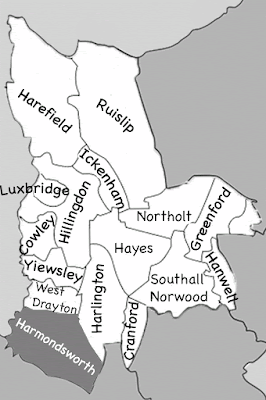 |
| England showing Historic Shires with Middlesex highlighted |
Empire
Multiple Kingdoms or large regions under the same crown are typically known as an Empire. Examples would be Angevin Empire which at different times contained England, Wales, Scotland, Ireland, Normandy, Aquitaine, Brittany and other bits of France. Typically they function similar to a Kingdom with various King ruling it all acting as king of the bit and pieces as well.
Kingdom
At the next level we have the Kingdom.All land in the Kingdom is owned by the crown. That's a lot of territory for one person to control so the crown subdivides everything into Duchies & Shires.
Duchy
A Duchy is basically the same as a Shire (below) except it is controlled by a Duke who is usually a member of the Royal Family and uses the Duchy as a vacation spot and money generator so they can enjoy life at court.
Shires
The term Shire and County are used somewhat interchangeably with shire being older and a bit cooler sounding so I'll use Shire for consistency sake. A shire is held by an Earl. William the Conquerer tried to bring the title Count over from France but it never gained traction. Oddly enough the Earl's wife is known as a Countess, probably because Earless sounded daft. The Shire boundaries throughout England haven't changed much until more modern times although some have been busted up a bit.
An Earl controls most of the land in the Shire (at least land not directly controlled or granted out to someone else by the King). The Earl may also control land in other counties as if he were a normal Baron in those areas.
High Sheriff
To keep a tight reign on things the King usually appoints a High Sheriff yearly. The High Sheriff had number of Sheriff's under their charge and would be responsible for enforcing law and order throughout the Shire (not so much collecting taxes despite some tales, tax collection was primarily the responsibility of the Duke or Earl). The High Sheriff was responsible for organizing the Shire militia, chasing outlaws (tales got that right at least), and dealing with court cases. The High Sheriff was often a commoner but had the power of the King behind them.
Hundreds
 |
| Middlesex hundreds with Elthorne highlighted |
Barony
A barony was the same as a Fief (below) except held by a Baron, one of the lowest of all hereditary titles. Being a hereditary title meant the Baron had the ability to pass property to descendants which meant in time a Barony was likely to expand to a number of fiefs through marriage and the blessings of the crown. Baronies were granted directly by the crown rather than by the Earl.
Fief
Each Hundred was subdivided into fiefs. This isn't exactly true as the fief boundaries and hundred boundaries do not always line up but things get messy if you nit-pick. A feif was usually granted by the Earl to ensure someone loyal was watching the fiefs in the Shire (with the exception of Baronies which the Earl had little control over).
 |
| Elthorne Hundred with Harmondsworth highlighted |
The Lord of the manor lived in a house known as a manor or manor house (over time the terms fief and manor became interchangeable). A manor might be fortified, in risky areas it might be a very simple Keep, but more often than not during the medieval period the manor was just a nicer houses than the peasants had.
Parish
The Church divided the Kingdom up into a subinfeudation of their own, but were kind enough to mostly duplicate the civil system. The Church used the term Parish for a fief. Each fief had a church to serve the needs of the worshipers in that fief. Over time the terms Parish and fief became interchangeable.
No comments:
Post a Comment